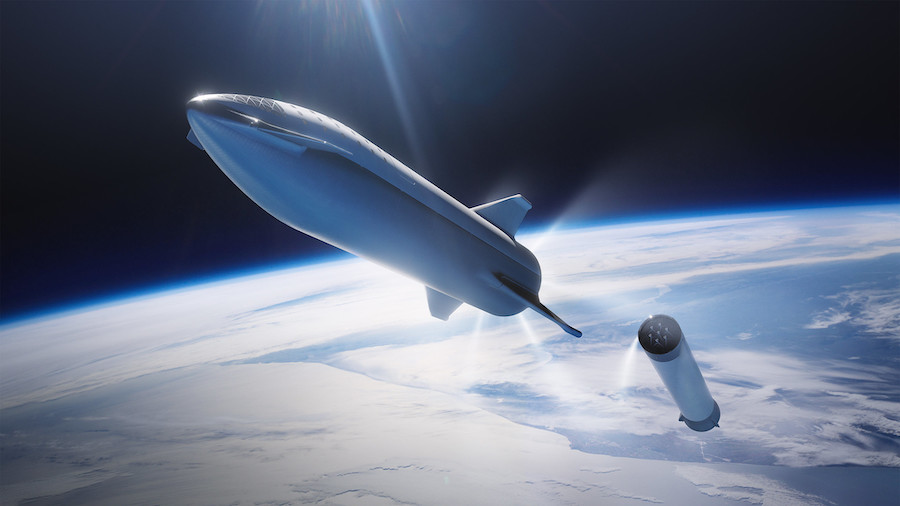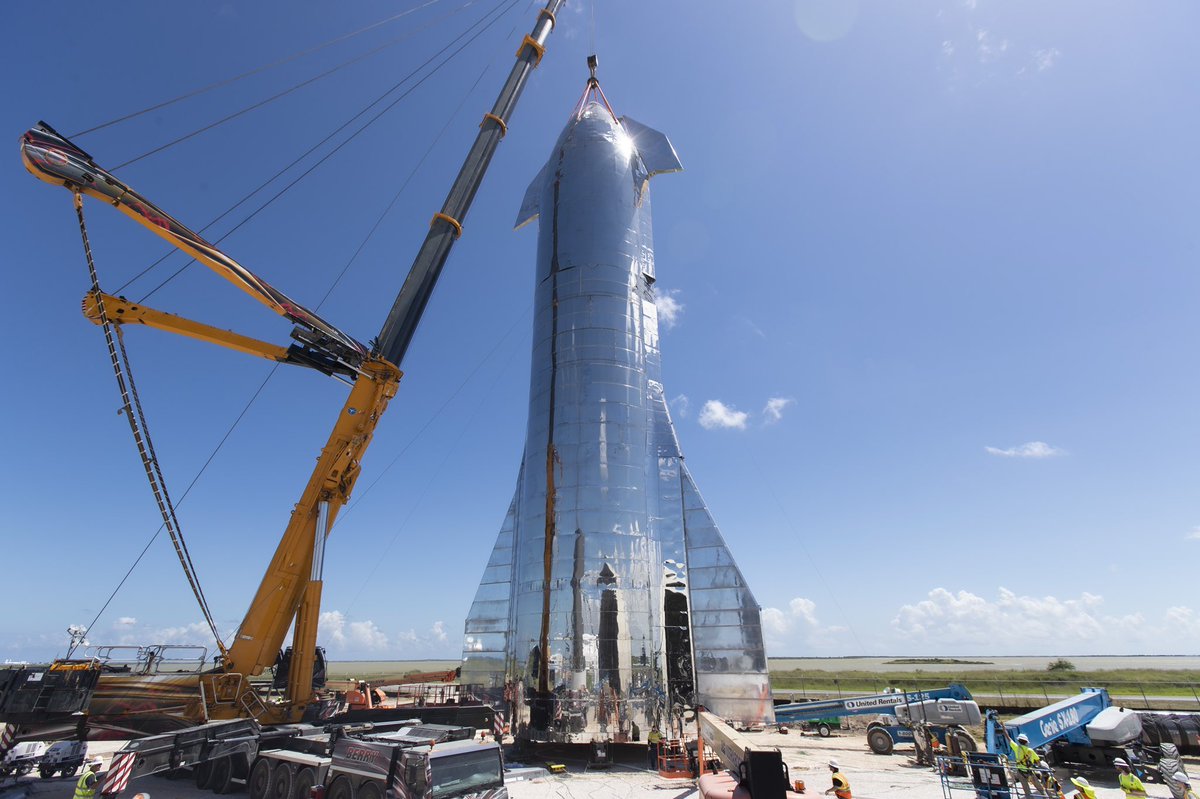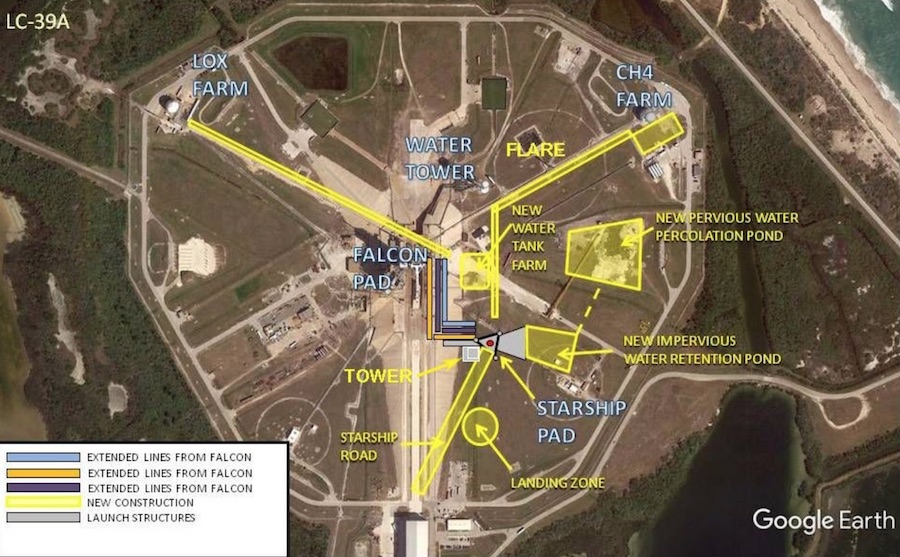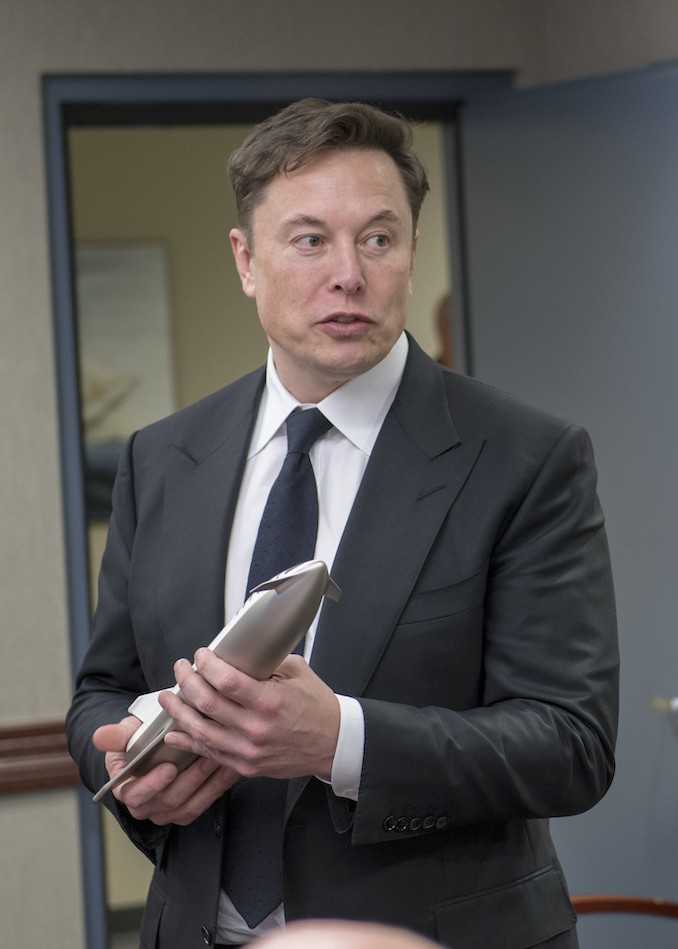Elon Musk to provide update on SpaceX’s Starship this weekend – Spaceflight Now

In the last few months, teams of SpaceX engineers working on the flat coastal plains of South Texas and in a nondescript industrial yard on Florida’s Space Coast have been building two futuristic-looking stainless steel rockets — or Starships — prototypes for a reusable vehicle that could one day ferry people to Mars.
SpaceX founder and chief executive Elon Musk plans an update on the progress of the Starship program Saturday at the company’s test and launch facility at Boca Chica, Texas.
The Starship, coupled with a massive first stage booster named the “Super Heavy,” will eventually replace the company’s Falcon 9 and Falcon Heavy rockets, along with the Dragon spacecraft used for cargo and crew missions, the company says.
The presentation Saturday is expected to be the most comprehensive update on SpaceX’s plans for the Starship and Super Heavy, and for interplanetary space travel in general, in more than a year.
“By creating a single system that can service a variety of markets, SpaceX can redirect resources from Falcon 9, Falcon Heavy and Dragon to Starship—which is fundamental in making the system affordable,” SpaceX says on its website.
SpaceX says both the Super Heavy and the Starship vehicles — the first and second stage of a new powerful launcher — will be fully reusable. Both stages will be powered by clusters of methane-fueled Raptor engines, which are also a new development for SpaceX.
“An important question we have to answer is, ‘How do we pay for this system?’” SpaceX says on its website. “The answer lies in creating a single system that can support a variety of missions. SpaceX can then redirect resources from Falcon 9, Falcon Heavy and Dragon to this system.”
According to previous SpaceX statements, the Super Heavy will return to Earth for a vertical landing after launching the Starship into space. Meanwhile, the Starship, with its own rocket engines, could deliver satellites into orbit “at a lower marginal cost per launch than our current Falcon vehicles,” SpaceX says.
The Starship could also ferry crews to space stations, the moon and Mars. Once SpaceX adds in-space refueling capability to the Starship, the vehicle could deliver up to 100 tons of useful payload to the surface of the moon or Mars, or carry as many as 100 people on long-duration, interplanetary voyages.
Musk has said the Starship could also be used for point-to-point transportation around Earth, enabling intercontinental flights in minutes instead of hours.
The combined vehicle is expected to stand nearly 400 feet (118 meters) tall and measure around 30 feet (9 meters) wide, according to the most recent figures released by SpaceX.
Musk originally unveiled details of his proposed architecture for interplanetary spaceflight in 2016 at the International Astronautical Congress, an annual space conference. Known then as the Interplanetary Transport System, or ITS, Musk’s design included a 39-foot-wide (12-meter) first stage with 42 Raptor engines and a second stage with nine Raptor engines.
The billionaire entrepreneur revealed a downsized 30-foot-diameter design a year later at 2017’s IAC conference with fewer Raptor engines. Last year, Musk renamed the two main pieces of the modified launch vehicle, previously called the BFR, or “Big Falcon Rocket,” the “Super Heavy” and “Starship.”
Musk has provided basic updates on the evolving Super Heavy and Starship design on Twitter.
The Super Heavy first stage intended to boost the Starship off the ground will be powered by around 35 Raptor engines, according to Musk. The ultimate Starship design, at least as currently understood, will use six Raptor engines for deep space missions — three designed to operate in the atmosphere, and three with larger nozzles optimized for in-space firings.
Japanese billionaire Yusaku Maezawa announced last year he plans to fly on SpaceX’s next-generation spaceship on a flight around the moon as soon as 2023.
Musk has said he wants the Starship to be ready for a flight to Mars without humans in 2022, and a crewed flight to the Red Planet could follow as soon as 2024.
But achieving those goals will require rapid progress, and Musk’s presentation Saturday in South Texas is expected to unveil the first fully-assembled Starship prototype as SpaceX gears up for shakedown flights within Earth’s atmosphere.

Working in the open, technicians in South Texas added actuating aerodynamic fins to the silver Starship test vehicle this week. Musk has tweeted photos of the Starship showing three methane-fueled Raptor engines mounted in a triangle configuration on the rocket’s base, in a configuration reminiscent of the space shuttle’s main engines.
A crane lifted the Starship’s nose cone on top of the vehicle Friday.
SpaceX has designated the test rocket under construction at Boca Chica, located on the Gulf coast a few miles north of the U.S.-Mexico border, as the Starship Mk. 1 vehicle. Another prototype being assembled in Cocoa, Florida, near the Kennedy Space Center, has been named Starship Mk. 2.
The Mk. 1 and Mk. 2 teams are competing with each other. In August, Musk said the Florida team “started several months behind, but (is) catching up fast. This will be a super fun race to orbit, moon & Mars!”
With its nose cone attached, the Starship prototypes will stand around 164 feet (80 meters) tall and weigh around 200 tons, Musk says. A fully-fueled Starship Mk. 1 vehicle will weigh around 1,400 tons.
Musk has said the test vehicles are based on SpaceX’s “orbit-class Starship design.”
But orbital flights will come later.
SpaceX will begin flying the Starship testbeds on suborbital flights in Earth’s atmosphere to demonstrate the rockets’ structural strength, the performance of their Raptor engines, and controllability during takeoff and landing.
The Starship is designed for vertical takeoffs and landings, similar to the method SpaceX uses to return Falcon rocket boosters to Earth for refurbishment and reuse.
A scaled-down version of the Starship with a single Raptor engine, called the Starhopper, completed a 500-foot (150-meter) test flight Aug. 27. The stubby three-legged vehicle, which space enthusiasts likened to a flying water tower, flew with a single Raptor engine, the most powerful rocket powerplant developed by SpaceX to date.
The Starhopper has been retired as a flight test vehicle in favor of the full-scale Starship.
The Starship Mk. 1 and Mk. 2 vehicles will initially fly with three Raptor engines, which consume a mixture of methane and liquid oxygen. The early versions of the Raptor engines can produce up to 440,000 pounds of thrust at sea level, guzzling propellants chilled to near their freezing points, a measure intended to increase efficiency, thrust and propellant density, allowing more fuel to be loaded into the launch vehicle.
Three Raptors on a Starship pic.twitter.com/UrRiD62EVk
— Elon Musk (@elonmusk) September 26, 2019
An application filed by SpaceX with the Federal Communications Commission on Sept. 9 requested authority to operate a telemetry station in support of a Starship Mk. 1 test flight to an altitude of up to 66,000 feet, or 20 kilometers, as soon as next month.
Asked on Twitter earlier this week when the Starship Mk. 1 could be ready for its first flight, Musk replied: “This is quite a complex beast, but hopefully within a month or so.”
The Starship will descend to a landing at a site adjacent to the launch pad at Boca Chica, settling back to the ground on six landing legs.
Higher and faster test flights are expected to follow for the Starship Mk. 1 vehicle in Texas, and the Starship Mk. 2 testbed from launch pad 39A at NASA’s Kennedy Space Center in Florida.
Once SpaceX conducts the initial atmospheric test flights of the Starship, Musk tweeted that an orbital launch attempt could occur “shortly thereafter.”
Musk has not detailed how SpaceX plans to fly the Starship into orbit on early flights, or where SpaceX will eventually build the Super Heavy boosters. That information could be revealed in Musk’s presentation Saturday.
He said in May that the Starship could theoretically reach Earth orbit without a boost from the Super Heavy first stage. But it couldn’t carry a heat shield or enough reserve propellant for re-entry and landing.
“It technically could (achieve orbit by itself), but wouldn’t have enough mass margin for a heat shield, landing propellant or legs, so not reusable,” Musk tweeted.

A Federal Aviation Administration environmental impact statement for SpaceX’s Boca Chica launch site updated in May suggested the company plans a three-phase Starship test program lasting two-to-three years, beginning with fueling tests, static fire tests, and low-altitude flights.
The final phase of the test program, as outlined in the FAA document, would involve a Starship test flight to an altitude of around 62 miles, or 100 kilometers. On that test flight, the Starship would conduct a flip maneuver at the edge of space and re-enter the atmosphere for landing back at Boca Chica.
Meanwhile, construction has started at pad 39A at NASA’s Kennedy Space Center to build a new launch mount for the Starship test flights in Fl0rida. At some point, perhaps in the coming weeks or months, SpaceX plans to transport the Starship Mk. 2 prototype to pad 39A via a combination of an overland transporter and a barge.
“Designed by NASA to support the first human missions to the Moon, Launch Complex 39A is one of the world’s most capable launch sites with the infrastructure to support a wide variety of mission profiles,” a SpaceX spokesperson said in a statement in August. “As Starship development accelerates, SpaceX is working with our partners to continue upgrading LC-39A’s infrastructure to build upon past achievements and advance new capabilities in space.”
SpaceX has no current plans to fly the Starship vehicle from its other two launch sites — pad 40 at Cape Canaveral Air Force Station, or from Space Launch Complex-4 at Vandenberg Air Force Base in California.

The U.S. government, so far, has little role in the privately-run Starship program.
NASA is focusing on the Space Launch System, Orion spacecraft and the development of a commercial lunar lander to achieve the Trump administration’s goal of landing astronauts the moon by 2024.
SpaceX wrote in an environmental impact statement outlining the company’s future construction plans at pad 39A that the development of the Super Heavy/Starship vehicle “may support NASA in meeting the U.S. goal of near-term lunar exploration.”
The U.S. Air Force, which needs powerful new rockets to carry satellites into orbit, has funded a fraction of the Raptor engine’s development costs. But the military did not select SpaceX last year as part of a round of rocket development contracts that went to SpaceX rivals United Launch Alliance, Blue Origin and Northrop Grumman.
SpaceX filed a lawsuit against the U.S. government in May protesting the Air Force’s rocket development contracts awarded last year to SpaceX’s competitors.
Meanwhile, the Air Force has received bids from SpaceX, ULA, Blue Origin and Northrop Grumman for lucrative military contracts for as many as 34 launches between 2022 and 2026. The so-called “Phase 2” launch service procurement is the next stage in a multi-step, multi-year effort by the Air Force to select two contractors to cover the military’s future satellite launch needs, and end reliance on foreign-made rocket engines, such as those used by ULA’s Atlas 5 booster.
ULA and SpaceX currently launch most of the U.S. government’s military and intelligence-gathering satellites.
SpaceX said it was the only one of the four bidders to offer the Air Force a launch system that is currently flying, making the company the “lowest-risk solution” for the military’s most critical satellites. The Falcon 9 and Falcon Heavy rockets are already certified by the Air Force, and SpaceX indicated it planned to use the Falcon rocket family to compete for the Phase 2 launch service contracts.
ULA is developing the Vulcan-Centaur rocket to replace its Atlas and Delta rocket fleet. Blue Origin, founded by Amazon.com billionaire Jeff Bezos, is developing the New Glenn rocket, and Northrop Grumman is working on the new OmegA launcher.
While the ULA, Blue Origin and Northrop Grumman rockets are based on new designs, none look quite like the Starship.
Blue Origin is designing the first stage of its New Glenn rocket to land and be launched again, and ULA says it intends to eventually recover Vulcan main engines for reuse. But neither vehicle comes with the same lofty ambitions SpaceX has attached to the Starship.

SpaceX says it will keep flying Falcon 9 and Falcon Heavy rockets, along with Dragon crew and cargo capsules, while engineers advance work on the Starship and Super Heavy vehicles.
“One thing that we want to do is we clearly want to innovate, and it’s hard to innovate in this industry,” said Hans Koenigsmann, SpaceX’s vice president of build and flight reliability, in an Aug. 19 panel discussion during an aerospace industry conference.
“I’m not sure what it is, but there’s a certain amount of resistance to continuous innovation. So the easiest way is to have a new development at the same time while you still have a reliable product flying,” Koenigsmann said.
SpaceX is also using its operational vehicles to test technology designed for the next-generation Starship. A Dragon cargo capsule re-entered the atmosphere to complete its most recent mission Aug. 27 with a patch of Starship heat shield tiles.
“I feel like that makes a very healthy company, to keep on one side a reliable product line running, and on the other side an innovative branch or an innovation department, basically, that builds a next-generation launch vehicle that is then capable to return both the first stage and the second stage, which is the holy grail in terms of reusability and keeping your launch costs really at a low point,” Koenigsmann said.
Koenigsmann said SpaceX’s Falcon rockets are currently best suited to directly support NASA’s Artemis moon program. But that might change before 2024.
“In terms of Artemis and ongoing projects, we have Falcon Heavy there as the product being able to provide cargo services to Artemis, and obviously Falcon 9 will soon be able to provide crew, too,” he said. “So we have that side of the business, and when we phase in the other side with the new vehicles, it is in line right now with that (2024) timeframe. But also I want to point out that these timeframes are dependent, obviously, on resources — how much resources we can put in. The more resources we have available, the faster we can bring Starship online and be in that timeframe.”
SpaceX will attempt an orbital launch with the Starship vehicle “as soon as possible,” Koenigsmann said.
“Those are challenges to us as the engineers, and to us as a company, from Elon directly,” he said. “People take this very seriously. They work very hard to make sure that we can fly as soon as possible.
“I want to be a little bit cautious here, and just say I can guarantee these people work as fast as they can,” he said. “We will beat any other time schedule that’s out there.”
Email the author.
Follow Stephen Clark on Twitter: @StephenClark1.






